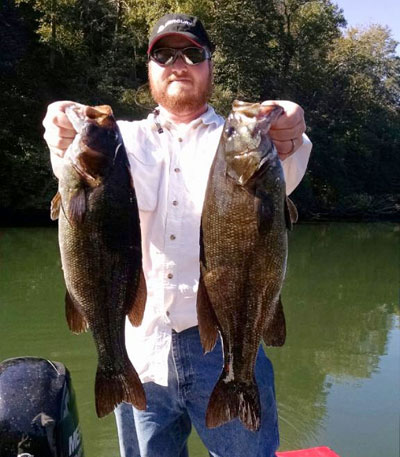
Last month, I briefly mentioned how we have had an exceptionally successful year for trophy smallmouth bass. I want to expand a bit on that this month, especially since December through March have always been my best months for true trophies. Over the last couple of months, I have had 11 people catch the biggest smallmouth of their lives, and I am hoping the rest of the year, and the early parts of next year, only improve. I simply love to target big smallies; in fact, while I can and do guide for anything that swims in Western North Carolina, guiding for smallmouth bass is a staple of my business. They are without a doubt my favorite species to target and catch.
Why do I love smallmouth so much? A key reason is that their inconsistency and general nature make them a challenge no matter how many times you fish for them. Aside from that, pound for pound, they are the hardest pulling and most acrobatic species there is. If they got much bigger, I don’t honestly know how you could land some of them. Another reason I enjoy them so much is because of their looks. Nothing compares to the brown of a big smallmouth, and we are blessed to have a color variation up here that can sometimes be so dark as to be almost black. I think a final reason I love the true trophies so much is because of their rarity.
There are very, very few places in the world where you can go and expect to have a more than decent chance at catching a 5 plus pound smallmouth. I am not saying it doesn’t happen: however, your odds of winning the lottery are roughly equal to catching a true trophy smallmouth on most bodies of water. Luckily, I have been blessed to guide in an area where big ones live, and catching a true monster is a definite possibility.
I primarily target smallmouth on Lakes Hiwassee and Apalachia. These two lakes are actually only physically separated by Hiwassee Dam, but don’t let their proximity fool you. They have essentially nothing in common. Hiwassee is by far the bigger of the two, and is a more typical highland lake-type fishery. It is also a more conventional lake in that it exists primarily for flood control and hydroelectric power generation, and it offers easier access. The state record smallmouth is from Hiwassee, and it is a traditional hotspot for smallmouth in the state. However, the proliferation of spotted bass in the lake appears to have hurt the smallmouth numbers. They appear to simply be outcompeting the smallmouth. Whereas Hiwassee used to be primarily a smallmouth lake where you caught an occasional spotted bass, it is turning into more of spotted bass lake where you also catch smallmouth. Fortunately, the winter months have always been, and continue to be, the best months to catch fish of all kinds on Hiwassee, especially smallmouth.
Lake Apalachia is the other lake where I guide for smallmouth. Apalachia is a hidden jewel, and I think it offers some of the best true trophy smallmouth fishing in the country. In fact, I don’t really know where you could travel to have a better chance at a truly “once in a lifetime” smallmouth. I think there are a couple of reasons for this. First, it is in the comparative middle of nowhere, and its remote nature and complete lack of nearby amenities helps keep pressure down. Second, the lake has extremely limited access, and that access is exceptionally difficult, and at times downright dangerous, to navigate unless you are extremely familiar with the lake. Finally, the fish in the lake are not the same as the smallmouth most people target, or at least don’t exist in the same conditions. Allow me to elaborate.
The nature of this body of water dictates that the fish behave differently here than anywhere else I have ever fished for them (and I have fished for them in a lot of places). What I mean by this is that Apalachia is what is known as a river-run reservoir. Water is meant to pass through this lake and not be stored long-term. Water levels can, and often do, fluctuate as much as 8 feet in a day of fishing (and by fluctuate I mean start out with a full lake, watch it drop 8 feet, and then watch it fill back up again). What this means for the fisherman is that there are many, many more variables to contend with. Fish react differently when the current is running than they do when it isn’t. They act in different ways when the lake is filling, and they also change their behavior in still more ways when the TVA is backfilling from Apalachia into Hiwassee. However, the puzzle of Apalachia is more than worth it. I would love to have the time to go into tactics for catching big, bad smallmouth in Hiwassee and Apalachia, but that is a whole other column.
If you are interested in a big smallmouth from Hiwassee or Apalachia or a big spot on Chatuge, please give me a call at 865-466-1345. I know the weather is about to get cold, but that just means the fishing should get even hotter. Have a great day!
Aaron Kephart, Mountain Lakes Guide Service, 865-466-1345.